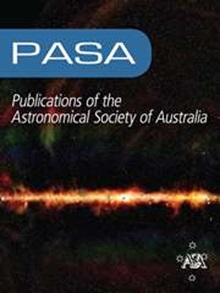On bursty star formation during cosmological reionization - how does it influence the baryon mass content of dark matter halos?
IF 4.6
3区 物理与天体物理
Q1 ASTRONOMY & ASTROPHYSICS
Publications of the Astronomical Society of Australia
Pub Date : 2024-05-13
DOI:10.1017/pasa.2024.39
引用次数: 0
Abstract
The baryon mass content (i.e. stellar and gas mass) of dark matter halos in the early Universe depends on both global factors - e.g. ionizing ultraviolet (UV) radiation background - and local factors - e.g. star formation efficiency and assembly history. We use a lightweight semi-analytical model to investigate how both local and global factors impact the halo baryon mass content at redshifts of关于宇宙再电离过程中的爆发性恒星形成--它如何影响暗物质晕的重子质量含量?
宇宙早期暗物质光环的重子质量含量(即恒星和气体质量)取决于全局因素(如电离紫外线(UV)辐射背景)和局部因素(如恒星形成效率和组装历史)。我们使用一个轻量级半分析模型来研究局部和全局因素如何影响 z ≥ 5 红移时的光环重子质量含量。我们的模型包含了恒星形成与它们产生反馈之间的时间延迟(0 ≤ td/Myr ≤ 30),它可以驱动恒星形成的爆发;还包含了与质量和红移相关的紫外背景,它捕捉了宇宙学再电离对气体吸积到光环上的影响。我们使用具有统计代表性的光环组装历史,并假定宇宙气体吸积率与光环质量吸积率成正比。延迟(td>0)反馈导致气体质量随宇宙时间的振荡,而瞬时反馈(td=0)无法捕捉到这种行为。高效的恒星形成会驱动更强的振荡,而强反馈会影响振荡发生的时间;相比之下,低效的恒星形成和弱反馈会产生与瞬时反馈模型中观测到的类似的长期行为。如果延迟反馈时间尺度过长,光环会保留其气体储层,但反馈会抑制恒星形成。根据我们的模型预测,z ≤ 10时的低质量系统(光环质量 mh ≤ 107M⊙)应该是强气体缺乏的(mg → 0),而质量较高的系统则保留了它们的气体库,因为它们的质量足以通过宇宙再电离继续吸积气体。有趣的是,在质量较高的光环中,中位 m⋆/(m⋆ + mg) ≃ 0.01 - 0.05,但当反馈延迟时,中位 m⋆/(m⋆ + mg) ≃ 会小 3-5 倍。我们的模型不包括种子超大质量黑洞反馈,而这是解释早期宇宙中大质量淬火星系的必要条件。
本文章由计算机程序翻译,如有差异,请以英文原文为准。
求助全文
约1分钟内获得全文
求助全文
来源期刊
CiteScore
5.90
自引率
9.50%
发文量
41
审稿时长
>12 weeks
期刊介绍:
Publications of the Astronomical Society of Australia (PASA) publishes new and significant research in astronomy and astrophysics. PASA covers a wide range of topics within astronomy, including multi-wavelength observations, theoretical modelling, computational astronomy and visualisation. PASA also maintains its heritage of publishing results on southern hemisphere astronomy and on astronomy with Australian facilities.
PASA publishes research papers, review papers and special series on topical issues, making use of expert international reviewers and an experienced Editorial Board. As an electronic-only journal, PASA publishes paper by paper, ensuring a rapid publication rate. There are no page charges. PASA''s Editorial Board approve a certain number of papers per year to be published Open Access without a publication fee.

 求助内容:
求助内容: 应助结果提醒方式:
应助结果提醒方式:


